Pit Road 1/350 IJN Yugumo
|
KIT #: |
WB-09 |
|
PRICE: |
$ |
|
DECALS: |
One option |
|
REVIEWER: |
Tom Cleaver |
|
NOTES: |
|

While the Royal Navy and
U.S.
Navy ceased building destroyers following the First World War through the
mid-1930s since they had so many constructed during that conflict, the Imperial
Japanese Navy set the standard for destroyers during that same period.
The Imperial Navy’s General Staff determined that
heavily-armed destroyers would be crucial to their intended defeat of the
western navies in night actions.
While the destroyers built in the 1920s were good, it
was with what is called the Fubuki
class that first appeared in 1931 that the IJN created the type of ship that
would give nothing but grief to the
U.S.
Navy during the Second World War.
The Fubukis
were followed by several other classes of destroyers which gave incremental
improvement over the original design in terms of range and seaworthiness.
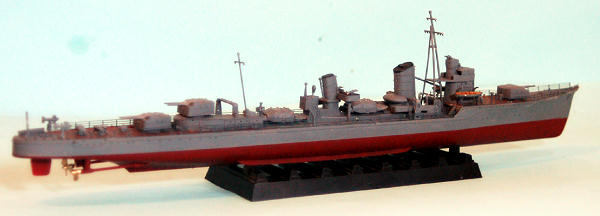 As
compared with western destroyers, these Japanese ships were a continuation of
the original “torpedo boat” design that became the destroyer.
But not only were they incredibly dangerous as torpedo
boats since they were the only destroyers that had the ability to perform a
torpedo reload during battle, and were armed during the war with the deadly Type
93 “Long Lance” torpedo, they were also among the most heavily-armed destroyers
in the world with their three turrets each carrying three 5" 50-caliber weapons.
With their magazines below the gun mounts, ammunition
was passed to the guns by hoists which
gave them a decided edge in rate of fire over other
destroyers which had open or partially shield mounts dependant on ammunition
passers carrying ammunition to them. The
U.S.
Navy didn’t add that to their designs until the Benson
class, and really didn’t match the Japanese destroyers until the advent of the
Sumner class in 1944, by which time
most of the Japanese ships had been sunk.
As
compared with western destroyers, these Japanese ships were a continuation of
the original “torpedo boat” design that became the destroyer.
But not only were they incredibly dangerous as torpedo
boats since they were the only destroyers that had the ability to perform a
torpedo reload during battle, and were armed during the war with the deadly Type
93 “Long Lance” torpedo, they were also among the most heavily-armed destroyers
in the world with their three turrets each carrying three 5" 50-caliber weapons.
With their magazines below the gun mounts, ammunition
was passed to the guns by hoists which
gave them a decided edge in rate of fire over other
destroyers which had open or partially shield mounts dependant on ammunition
passers carrying ammunition to them. The
U.S.
Navy didn’t add that to their designs until the Benson
class, and really didn’t match the Japanese destroyers until the advent of the
Sumner class in 1944, by which time
most of the Japanese ships had been sunk.
The last class of Japanese destroyer created was the
Yugumo class, built between 1941-44.
While the earlier classes had nine torpedo tubes in three triple-tube mounts,
the Yugumos had two four-tube mounts, which lightened them and gave better
sea-keeping ability.
Additionally, their main gun armament could be elevated
to 75 degrees, making them effective anti-aircraft weapons.
While they were originally equipped with an
anti-aircraft armament of two Type 93 13mm machine guns, the ships eventually
carried as many as 25 25mm anti-aircraft weapons in multiple-gun mounts and
sacrificed the 5" X mount to provide additional anti-aircraft armament after
1943.
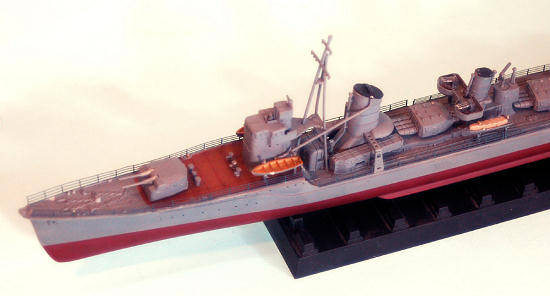 Along with the other Japanese destroyers, the Yugumo
class gave a good account for themselves in the battles in the
Solomon Islands
in 1942-43.
As the tide of battle turned against the Japanese, the destroyers
became the lifeline to Japanese island garrisons, providing food and ammunition
during nightly runs down “the sllot” and eventually evacuating most of the
survivors of the Japanese Army from
Guadalcanal
and other islands and the battles moved up the island chain.
Along with the other Japanese destroyers, the Yugumo
class gave a good account for themselves in the battles in the
Solomon Islands
in 1942-43.
As the tide of battle turned against the Japanese, the destroyers
became the lifeline to Japanese island garrisons, providing food and ammunition
during nightly runs down “the sllot” and eventually evacuating most of the
survivors of the Japanese Army from
Guadalcanal
and other islands and the battles moved up the island chain.
The destroyer Amagiri
nearly changed the course of world history when she rammed and sank PT-109 under
the command of Lt.(j.g.) John F. Kennedy in
Blackett
Strait
on
August 2, 1943.
Her captain, Lt. Commander Kohei Hanami, attended Kennedy’s inauguration as
Presdient in 1961.
Following the successful American invasion of New
Georgia
and the IJN defeat in the
Battle
of
Vella
Gulf,
the Japanese determined that they must evacuate the garrisons in the central
Solomons. Operating from a base at Horaniu on the north tip of Vella Lavella,
destroyers and barges were used for these evacuations.
By October, 600 soldiers remained.
On October 6, nine destroyers —
Fumizuki, Matsukaze, Yunagi, Akigumo, Isokaze, Kazegumo, Yugumo, Shigure,
and Samidare departed the base under
the command of Rear‑Admiral Matsuji Ijuin to rescue them.
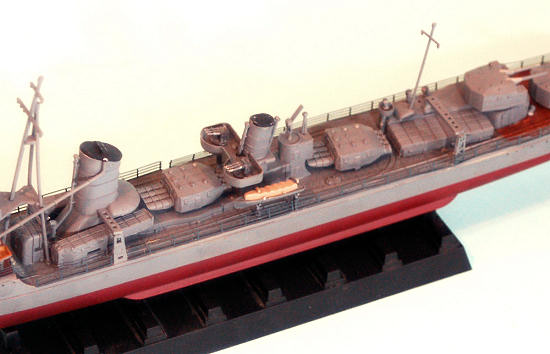 By this point in the Solomons campaign, the Americans
felt they had taken the measure of the Japanese in night battles and that their
radar-directed gunfire could overcome the Japanese superiority in night fighting
tactics and the Long Lance torpedo.
On the night of October 6-7, 1943, they learned the
Japanese could still bite.
By this point in the Solomons campaign, the Americans
felt they had taken the measure of the Japanese in night battles and that their
radar-directed gunfire could overcome the Japanese superiority in night fighting
tactics and the Long Lance torpedo.
On the night of October 6-7, 1943, they learned the
Japanese could still bite.
After successfully escorting the barges and withdrawing
the troops, Yugumo, first in line,
spotted an American force composed of the destroyers
Selfridge, Chevalier, and O'Bannon,
commanded by Captain Frank R. Walker approaching Vella Lavella from Vella Gulf
at 2230.
Unknown to the Japanese at the time,
the destroyers Ralph Talbot,
Taylor, and La
Vallette were operating off the west coast of Vella Lavella.
At 2245, Walker’s three destroyers managed to pick up
radar targets against the island backdrop.
Walker didn’t wait for the second division to reinforce
him but attacked immediately. Both sides launched torpedoes and opened fire at
2300.
Yugumo was hit several times in
the opening minutes of battle, but she charged the Americans and launched all
her torpedoes, one of which hit Chevalier
in her forward magazine just as she got her torpedoes away. In the confusion,
O’Bannon collided with
Chevalier and the two destroyers were locked
together.
Attacking alone, Selfridge
fired at Yugumo at 2306, only to be
struck herself by a torpedo fired by another Japanese ship immediately after
firing her torpedoes.
Two torpedo hits, one from Chevalier
and one from Selfridge, knocked out
Yugumo’s steering.
In the meantime, O’Bannon
was able to open fire on Yugumo despite
being entangled with Chevalier.
Yugumo went down at 2310 under
fire from O’Bannon, taking 138 of her
crew with her,
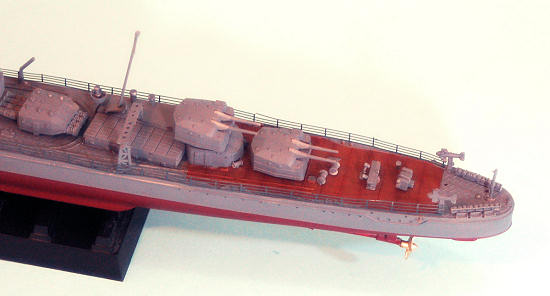 including
her captain, Commander Osako.
including
her captain, Commander Osako.
The second division of American destroyers was still 15
minutes from contact with the Japanese force.
Admiral Matsuji ordered combat broken off with the three
damaged American ships after spotting the three oncoming destroyers which were
misidentified as U.S. light cruisers. The eight Japanese destroyers successfully
disappeared into the darkness, with U.S. radar unable to pick them up against
the return from the islands in the vicinity.
U.S. PT boats ultimately rescued 78
Yugumo survivors, while 25 Japanese reached Japanese-held
territory in an abandoned U.S. lifeboat.
Unable to contain the damage of
Yugumo’s torpedo, Chevalier
could not be saved and was sunk at 0300, October 7, The three month campaign in
the central Solomons had resulted in the lost of six American ships, while the
Japanese had lost 16.
 The 1/350 Yugumo
was released by Pit Road several years ago and is no longer in production, but
probably can be found through kit collectors and such.
It was probably not widely produced, and in fact kits of
Japanese Second World War destroyers are a rare breed indeed, with the only
other kit in 1/350 - the Yukikaze -
having been produced by Hasegawa in 2008 and also no longer in production, but
is available at Sprue Brothers among others.
The 1/350 Yugumo
was released by Pit Road several years ago and is no longer in production, but
probably can be found through kit collectors and such.
It was probably not widely produced, and in fact kits of
Japanese Second World War destroyers are a rare breed indeed, with the only
other kit in 1/350 - the Yukikaze -
having been produced by Hasegawa in 2008 and also no longer in production, but
is available at Sprue Brothers among others.
Since I have both kits, with Yukikaze languishing these
past four years in the “to do” pile, I can say that this kit is far simpler,
with fewer parts on only four sprues.
It differs from the Hasegawa kit which is a full-hull
model divided vertically in halves by being the more traditional division at the
waterline, with an upper and lower hull allowing for a waterline model to be
built.
No photoetch is provided in the kit.
Construction was simple.
I glued the upper and lower hull together, then
proceeded to paint.
Japanese ships are easy to paint, since they are overall
grey with deck brown.
Tamiya has bottles of Sasebo and Kure greys as used by
those two
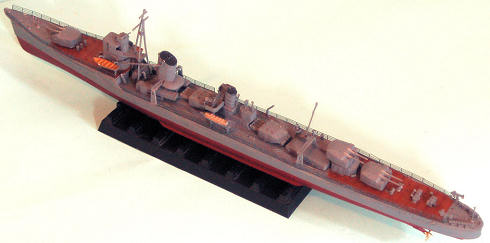 shipyards,
as well as a bottle of “Deck Color,” which is the shade of brown used for the
linoleum.
I painted the lower hull Hull Red, then painted the linoleum
areas, masked them off and then painted the rest Sasebo Grey (I have no idea if
that is specifically accurate; it was the paint I had on hand).
shipyards,
as well as a bottle of “Deck Color,” which is the shade of brown used for the
linoleum.
I painted the lower hull Hull Red, then painted the linoleum
areas, masked them off and then painted the rest Sasebo Grey (I have no idea if
that is specifically accurate; it was the paint I had on hand).
With everything painted, I proceeded to assemble the
simple superstructures, the turrets, the stacks, etc.
The entire model was done over the course of a weekend
from opening the box to sitting it completed on its base.
I used left-over photo-etch railing (never throw away
anything!) but did not fully rig the masts.
I for one did not know as much about Japanese destroyers
before I started this project than I do now, though I was aware they were tough
opponents in the Solomons campaign.
This is an easy kit to build that presents no problems.
If you can find it, it would be an excellent first ship
kit for a modeler.
Tom Cleaver
September 2012
Review kit courtesy of
my wallet.
If you would like your product reviewed fairly and fairly quickly, please contact the editor
or see other details in the
Note to
Contributors.
Back to the Main Page
Back to the Review Index Page


 As
compared with western destroyers, these Japanese ships were a continuation of
the original “torpedo boat” design that became the destroyer.
But not only were they incredibly dangerous as torpedo
boats since they were the only destroyers that had the ability to perform a
torpedo reload during battle, and were armed during the war with the deadly Type
93 “Long Lance” torpedo, they were also among the most heavily-armed destroyers
in the world with their three turrets each carrying three 5" 50-caliber weapons.
With their magazines below the gun mounts, ammunition
was passed to the guns by hoists which
gave them a decided edge in rate of fire over other
destroyers which had open or partially shield mounts dependant on ammunition
passers carrying ammunition to them. The
As
compared with western destroyers, these Japanese ships were a continuation of
the original “torpedo boat” design that became the destroyer.
But not only were they incredibly dangerous as torpedo
boats since they were the only destroyers that had the ability to perform a
torpedo reload during battle, and were armed during the war with the deadly Type
93 “Long Lance” torpedo, they were also among the most heavily-armed destroyers
in the world with their three turrets each carrying three 5" 50-caliber weapons.
With their magazines below the gun mounts, ammunition
was passed to the guns by hoists which
gave them a decided edge in rate of fire over other
destroyers which had open or partially shield mounts dependant on ammunition
passers carrying ammunition to them. The  Along with the other Japanese destroyers, the Yugumo
class gave a good account for themselves in the battles in the
Along with the other Japanese destroyers, the Yugumo
class gave a good account for themselves in the battles in the

 including
her captain, Commander Osako.
including
her captain, Commander Osako. The 1/350 Yugumo
was released by Pit Road several years ago and is no longer in production, but
probably can be found through kit collectors and such.
It was probably not widely produced, and in fact kits of
Japanese Second World War destroyers are a rare breed indeed, with the only
other kit in 1/350 - the Yukikaze -
having been produced by Hasegawa in 2008 and also no longer in production, but
is available at Sprue Brothers among others.
The 1/350 Yugumo
was released by Pit Road several years ago and is no longer in production, but
probably can be found through kit collectors and such.
It was probably not widely produced, and in fact kits of
Japanese Second World War destroyers are a rare breed indeed, with the only
other kit in 1/350 - the Yukikaze -
having been produced by Hasegawa in 2008 and also no longer in production, but
is available at Sprue Brothers among others. shipyards,
as well as a bottle of “Deck Color,” which is the shade of brown used for the
linoleum.
I painted the lower hull Hull Red, then painted the linoleum
areas, masked them off and then painted the rest Sasebo Grey (I have no idea if
that is specifically accurate; it was the paint I had on hand).
shipyards,
as well as a bottle of “Deck Color,” which is the shade of brown used for the
linoleum.
I painted the lower hull Hull Red, then painted the linoleum
areas, masked them off and then painted the rest Sasebo Grey (I have no idea if
that is specifically accurate; it was the paint I had on hand).